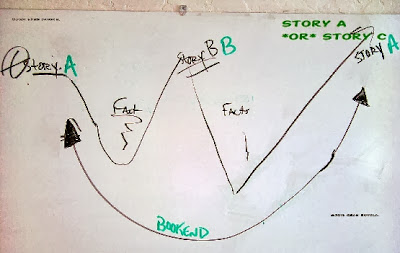As part of my recent binge of hard-core storytelling-practitioner blog posts, I thought I might share a white-board illustration with you that I created while my client and I were working. She found it useful. I did not intend to use this drawing as a blog post, so you are getting a raw piece of my mind here. Be gentle with any comments about my
 |
| The scribbles in the middle read "facts." |
My student, who works in inventory control in a large international business, was trying to create a 10-15 minute presentation. I showed her a model that I sometimes use in my own public speaking. It uses either two or three stories to "bookend" or support factual content.
As you can see from the drawing, I suggest that stories serve two purposes in a short presentation. They are the first high points that bring the energy of a presentation back up. They also serve as frames (or hooks or nets- however you want to read it) for the presentation of facts during her discussion. There is a typical ebb/flow level of energy in presentations as you can see in this white-board picture.
There can be either 2 or 3 short stories in this presentation model. The first "bookend" flow (as drawn on the board) uses two stories and is seen as:
Story A - Fact Set 1 - Story B- Fact Set 2 - Story A.
This second appearance of Story A is either the same type of additional illustration from Story A or a reminder from a lesson suggested in Story A. So, in a perfect white-board illustration I might have written A1 and A2.
Another way to do this presentation is to have a Story C at the end of the presentation that ties together the other stories and facts. I have noted that in the picture with some after-the-fact text added to the drawing.
Story A - Fact Set 1 - Story B- Fact Set 2- Story C
Of course, you will add your own introductory and closing comments, but for our meeting, we didn't need to write these on the board.
Other thoughts: I assume that you already understand that the stories would be connected to the content presented in the facts, perhaps to illustrate the reward or consequences of paying attention to the facts in the two sets. Also, the stories could be a mix of "real life" stories and a world-tale. One story, especially Story B, might be more of an anecdote and not a full story. It depends on your skill and your situation.
This is a good model for a short 10-15 minutes speech. You would adjust the process based on the time you have to speak. I have written about some other presentation models in the past as well.
I hope this is helpful.
******
The is the official blog for K. Sean Buvala, storyteller and storytelling coach. Written right out of our offices at Gangplank Avondale.




